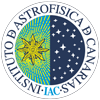![Color image (red=Halpha+[NII], green=[O III]5007) of the Ou5 nebula, obtained with NOT at Observatorio del Roque de los Muchachos, La Palma. Courtesy of R. Corradi.](/severoochoa/severoochoa2011-2015/images/imagenesweb/news/J_GarciaRojas_ou5colour_zoom2.jpg)
Problem of Chemistry of the Universe: some keys in planetary nebulae
27/04/2015
One of the methods most often used to measure the chemical composition of the universe is to analyze the spectra of the nebulae where stars are born or die. Each chemical element in the hot gas which makes up these nebulae emits radiation which is characteristic, in the form of spectral lines at particular wavelengths. Nevertheless the chemical composition which is inferred from a spectrum can vary depending on which physical mechanism produced the lines, and this still poses unsolved problems in astrophysics. A group of researchers at the IAC and the University of La Laguna (ULL), among them the Severo Ochoa postdoc Jorge García-Rojas, have carried out a detailed spectroscopic study of three nearby planetary nebulae which have binary stars at their centres, confirming that at least one of the factors behind this problem is the existence of two (or more) gas phases in these nebulae, with different temperatures, densities, and chemical compositions. This study has just been published in the specialist journal “The Astrophysical Journal”. >>Read more


